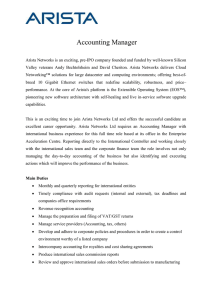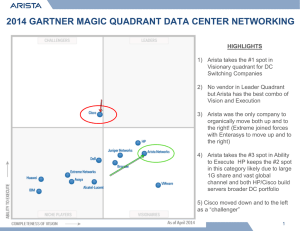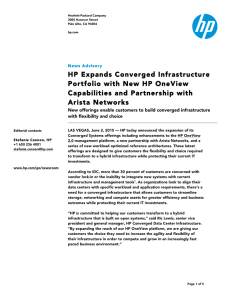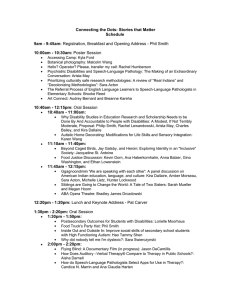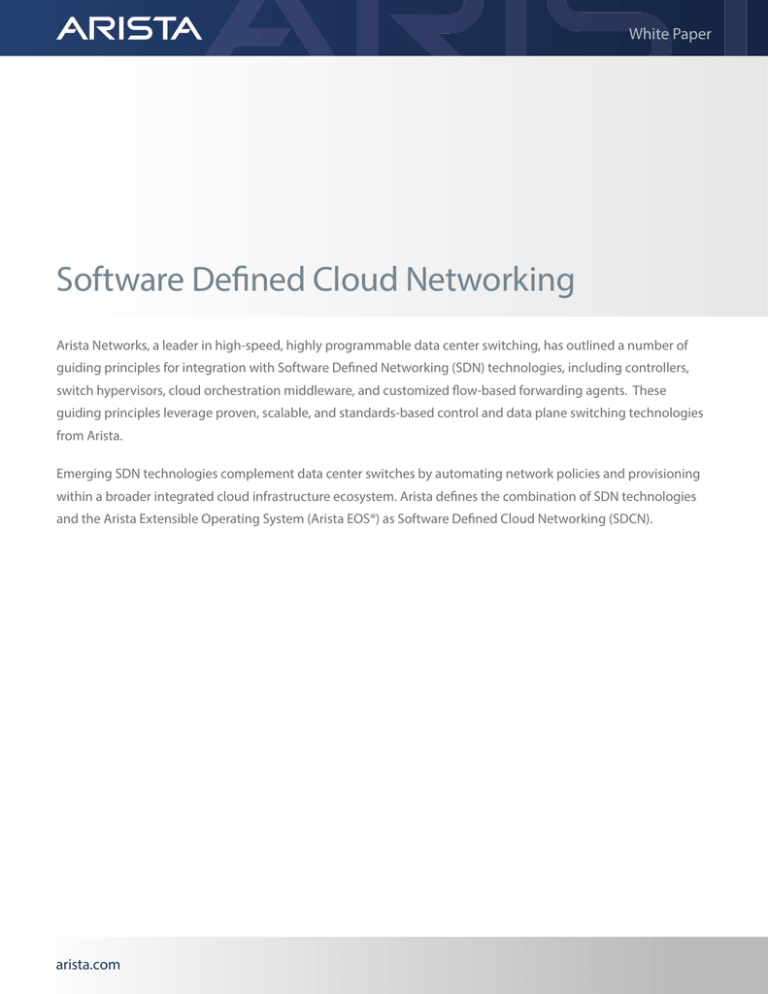
White Paper
Software Defined Cloud Networking
Arista Networks, a leader in high-speed, highly programmable data center switching, has outlined a number of
guiding principles for integration with Software Defined Networking (SDN) technologies, including controllers,
switch hypervisors, cloud orchestration middleware, and customized flow-based forwarding agents. These
guiding principles leverage proven, scalable, and standards-based control and data plane switching technologies
from Arista.
Emerging SDN technologies complement data center switches by automating network policies and provisioning
within a broader integrated cloud infrastructure ecosystem. Arista defines the combination of SDN technologies
and the Arista Extensible Operating System (Arista EOS®) as Software Defined Cloud Networking (SDCN).
arista.com
White Paper
Cloud Technology Shift
Ethernet networks have evolved significantly since their inception in the late 1980s, with many evolutionary changes leading to
the various switch categories that are available today (see Figure 1). Data center switching has emerged as a unique category,
with highly dense 10Gbps, 40Gbps, and now 100Gbps port-to-port wire-rate switching as one of the leading Ethernet networking
product areas. Beyond these considerable speed progressions, data center switching offers sub-microsecond switch latency
(measured in nanoseconds), zero-drop packet failover when failing over to redundant links, traffic load balancing for increased asset
optimization, and scaling in support of large carrier-class virtualized infrastructures.
While these state-of-the-art switching features leverage 30 years of progressive hardware and software technology evolution,
successful implementation of Arista SDCN requires a fundamental shift from closed, vendor-specific proprietary network operating
systems to open, extensible, externally programmable operating systems. This open extensibility requirement is driven by the
guiding principles of cloud data centers in which resources are managed dynamically as one integrated system made up of
compute, network, and storage.
Controllers that are external to the switches drive many of the hosting decisions and, as a result, must interface to the switches at the
network edge to ensure appropriate service mappings.
Closed network operating systems that are built on older design principles can, at best, offer one-off implementations and struggle
to support the growing list of different SDN controller form factors. Arista, on the other hand, is in a unique leadership position—the
industry award-winning modular Arista EOS can interact with multiple systems concurrently, handling external controller updates
and managing highly distributed switch forwarding states, both in real time. The Arista approach offers the best of both worlds,
providing service control to external controllers, while scaling with Leaf/Spine switching architectures for the most demanding
carrier-class cloud data centers.
Cloud Technology Shift
Prior to the shift toward virtualization and elastic computing, there were highly specialized infrastructure administrators—including
server, network, storage, and application specialists—that configured services within their domain statically, based on infrequent
change requests that came from the application community.
Figure 1: Software driven cloud networking evolution
arista.com
White Paper
Table 1: A stack approach to Arista SDCN
Stack
Examples
Benefits
Virtual machines
Web app framework
Scale up/down as needed
SDN controllers
OpenFlow, OpenStack, vCloud Suite,
vSphere
Orchestration, service abstraction and
positioning
Network virtualization
Scalable, multi-tenant virtual networks
Enables open workload mobility
Server hypervisor
x86 bare metal server abstrations
Elastic computing, resource optimization,
non-disruptive server upgrades
Storage
Network, direct-attached, SSD, Hadoop, big
data
Centralized VMDK for app mobility, software
patches
Cloud-enabled network
Arista EOS
Open and programmable for custom flows,
VM mobility, automated tenant onboarding
On average, with a legacy network operating system it took two to four weeks to configure and release into production a fully
integrated data center infrastructure for any new or refreshed application. Much of this two- to four-week time period was based on
the administrators coordinating with each other in an ad hoc manner on change control issues.
Cloud data centers run counter to this model, with highly virtualized and elastic workloads, time-of-day application demands, and
rapid provisioning requirements that are driven by service-catalog web-facing front ends. Administrators can no longer manually
coordinate provisioning events, manually update configuration databases, and fully test the system prior to hosting live inproduction environments. Highly virtualized cloud infrastructures drive the need for real-time configurations, switch topology data,
the ability to trace virtual machines (VMs) across physical and virtual resources end-to-end, and the ability to change or remap
tenants and VMs based on quality of service (QoS) and security policies. Network administrators cannot perform these functions
instantaneously, nor can they perform these functions in isolation. Integration with external controllers, cloud orchestration or
provisioning middleware, and service took weeks to configure, test, and release into production. Service level agreement (SLA)
management tools have become a core cloud infrastructure requirement (see Table 1).
Consider the case of a data center or cloud administrator. The physical attributes of servers, switches, and interconnects are well
known to the infrastructure administrators. In many cases, the MAC address of each server, its physical location (including floor, row,
and rack information), assigned IP address, physical and logical connections to the switch, and configuration files, are imported into
asset tracking and configuration database applications. This database information is important for pinpointing problems and
performing break/fix tasks in an efficient manner. In non-virtualized, non-cloud environments, this data is static and easy to maintain
by the administrators. In clouds, where servers are virtualized and the placement of these VMs is often changing, there is the
underlying infrastructure platforms (such as servers, switches, firewalls, and load balancers) based on these location changes.
In large-scale virtualized environments, the operator should not have to worry about MAC learning, aging, Address Resolution
Protocol (ARP) refresh, and the uploading of any VM location changes into a configuration database. The path from one device to
another should be known within a centralized topology database, with real-time updates. When integrated externally to cloud
controllers, the paths make network configuration, customized forwarding, and troubleshooting easier. The majority of data center
switches across the industry do not allow any forwarding path programmability from the outside. They are a closed black box that
the vendor controls, with preset forwarding path software and hardware algorithms. This is a clear case in which an external
controller offers value.
Similarly, there are other use cases—in traffic engineering for aggregating Test Access Points (TAPs) to a centralized collection point,
adding special headers to overlay Layer 2 traffic onto Layer 3 networks, classifying traffic based on content, monitoring congestion
and hash efficiency over a Link Aggregation Group (LAG) or Equal-Cost Multipath (ECMP) group, and so on. Programmable switches,
managed by external controllers, can address many of these cases.
arista.com
White Paper
SDN Overlays, Underlays or Both?
Enterprises are a complex mix of legacy and newer cloud-based applications. As the network architecture evolves to support the
next phase of cloud and virtual networking needed to bring these worlds together, it is important to look at the two main elements
in a Software Defined Network.
Overlay SDN
SDN overlays use network virtualization to separate, abstract and decouple the physical topology of networks from a ‘logical’ or
‘virtual’ topology by using encapsulated tunneling. This logical network topology is often referred to as an ‘Overlay Network’. In these
architectures some network features and functions are moved into overlays to control the data, specific flow or forwarding path. This
may include:
1. Software overlays to shift management functions from the control plane of the switch to servers
2. Specific network services such as load balancing, access control, fire walling and visibility Controllers for SDN overlays leverage
existing physical networks to deliver functions such as provisioning and visibility.
Underlay SDN
Controllers do not solve the broader set of complex high-performance network issues that exist at L2/L3/L4. To achieve that we
need an uncompromised wire-speed SDN data plane as the physical ‘Underlay Network.’ To best utilize the capabilities of an
SDN overlay while providing maximum transparency and performance, the underlying physical network must scale linearly and
programmatically interface in a seamless manner with new network virtualization capabilities with very little contention and
minimal end-to-end latency. The use of open standards and open APIs makes it possible to be controller agnostic and interoperable
with other network infrastructure elements such as Wi-Fi, load balancers and firewalls.
At the core of every cloud, customers demand scalability, resiliency, and 24-hour business-critical uptime every day of the year.
Hundreds of switches can easily be located within the same data center and need to instantaneously react to change events
anywhere within the topology without dropping packets or creating congestion conditions. To deliver on these requirements,
networking platforms have evolved with many of the data plane controller functions distributed and embedded. Link Aggregation
Control Protocol (LACP), Open Shortest Path First (OSPF), ECMP, and Border Gateway Protocol (BGP) are primary examples of
standards-based distributed controller functions (which are often referred to as traffic engineering protocols). Because the majority
of change events typically occur locally, a distributed approach allows the affected network node to operate independently, reacting
and resolving changes within split seconds with near-zero packet drop. This distributed approach provides the high-resiliency
behavior that is required for around-the-clock every-day uptime. As a result, networks today are rarely the root cause when there are
application outage conditions.
Best of Both Worlds: Software Driven Cloud Networking
Networking is critical to every IT organization that is building a cloud, whether the cloud is large or small. As a result, compromising
resiliency over traffic flow optimization is unlikely. The approach that is well suited for most companies is to let the network layers
perform their intelligent forwarding with standard protocols, and to use Arista SDCN to enhance the behavior of the network with
tighter integration at the application layers utilizing open APIs for programmability of the underlay network at every level, be it the
control plane, management plane or the data plane.
The more common Arista SDCN use cases include the following:
•
Network virtualization for multi-tenant configuration, mobility, and management of VMs
•
Customized flows between servers and monitoring/accounting tools (or customizable data taps)
•
Service routing to load balancers and firewalls that are located at the Internet edge
•
Big Data/Hadoop search placement and real-time diagnostics
arista.com
White Paper
Arista SDCN can greatly enhance and automate the operations that are associated with these use cases. Integration with an external
controller provides the customized intelligence for mapping, connecting, and tracing highly mobile VMs, while the distributed
protocols within the networking devices provide the best-path data forwarding and network resiliency intelligence across large
distributed topologies. The migration to private, public or hybrid clouds is revolutionary in technology, but evolutionary in adoption.
Arista endorses a broad spectrum of data, management and control plane capabilities to bring flexibility to our customers as shown
in Figure 2.
Figure 2: SDN approaches
The Four Pillars of Arista SDCN
Arista Networks believes that Ethernet scaling from 10Gb to 40Gb to 100Gb Ethernet—and even terabits— with well-defined
standards and protocols for Layer 2 and Layer 3 is the optimal approach for a majority of companies that are building clouds. This
scaling allows large cloud networks of 10,000 or more physical and virtual server and storage nodes today, scaling to 100,000 or
more nodes in the future without reinventing the Internet or having to introduce proprietary APIs.
At VMworld 2012, Arista demonstrated the integration of its highly distributed Layer 2 and Layer 3 Leaf/Spine architecture with
VMware’s Virtual eXtensible LAN (VXLAN) centrally controlled, overlay transport technologies. This integration offers unsurpassed
multi-tenant scalability for up to 16 million logically partitioned VMs within the same Layer 2 broadcast domain. VXLAN embodies
several of the Arista SDCN design principles and is a result of an IETF submission by VMware, Arista, and several other companies.
It is important to recognize that building such highly scalable and dense clouds is only part of the equation. Application mobility,
storage portability, self-service provisioning and automation, and dynamic resource optimization create new management and
operational challenges that are different from many traditional data centers, including those designed in the late 1990s (based on a
client/server architecture).
Arista has identified these cloud challenges and has been solving them methodically using the four pillars of Software Driven Cloud
Networking (see Table 3):
Pillar 1: Universal Cloud Network
Scaling cloud networking across multiple chassis via Multi-Chassis Link Aggregation Groups (MLAGs) at Layer 2 or Equal-Cost
Multipath (ECMP) at Layer 3 is a standards-based approach for scalable cloud networking. This approach ensures effective use
of all available bandwidth in non-blocking mode, while providing failover and resiliency when any individual chassis or port has
an outage condition. MLAG and ECMP cover all of the important multipath deployment scenarios in a practical manner, without
introducing any proprietary inventions. These technologies currently scale to 100,000 or more physical compute and storage nodes,
and to more than one million virtual machines.
The new Arista Spline® architecture introduced with the high-density host-aggregation platform from Arista enables large densities
of directly connected hosts to connect to a single-tier or two-tier network.
arista.com
White Paper
With the advent of next-generation multi-core server CPUs, as well as dense VMs and storage, this type of uncompromised Leaf/
Spine or Spline topology with non-oversubscribed capacity, uplink, downlink, and peer ports is paramount. These technologies are
commonly integrated with server link redundancy, both physically and logically. The industry standard is LACP. Arista has completed
interoperability, including configuration automation with VMware’s vSphere 5.1 release. This interoperability and configuration
automation ensures that links are configured correctly for load sharing and redundancy at the virtual network interface card (vNIC)
level.
Pillar 2: Single Image Layer 2/3/4 Control Plane
Some networking vendors are attempting to respond to SDN with three decades of networking control plane architectures
that are non-modular, non-database-centric, and proprietary. For these vendors, SDN integration requires multi-year, expensive
undertakings. Customers will receive proprietary implementations, with vendor lock-in at the controller level, as well as many
of their non-standard distributed forwarding protocols. Arista has seen these issues firsthand. Customers have requested Layer
2 and Layer 3 control interoperability with Arista switches as well as with switches from other vendors. Arista has had to debug
many of these non-standard protocols. In short, the switches from other vendors are very difficult to implement as part of an SDN
architecture, and they have proprietary tools for configuration and management. This is not the answer going forward.
Instead of these touted proprietary “fabric” approaches, standards-based Layer 2 and Layer 3 IETF control plane specifications plus
OpenFlow options can be a promising open approach to providing single-image control planes across the Arista family of switches.
OpenFlow implementations in the next few years will be based on specific use cases and the instructions that the controller could
load into the switch. Examples of operational innovations are the Arista Zero Touch Provisioning (ZTP) feature for automating
network and server provisioning and the Arista Latency Analyzer (LANZ) product for detecting application-induced congestion.
Pillar 3: Network-Wide Virtualization
By decoupling “the physical infrastructure” from applications, network-wide virtualization expands the ability to fully optimize and
amortize compute and storage resources with bigger mobility and resource pools. It therefore makes sense to provision the entire
network with carefully defined segmentation and security to seamlessly manage any application anywhere on the network. This
decoupling drives economies of scale for cloud operators. Network-wide virtualization is an ideal use case in which an external
controller abstracts the VM requirements from the network and defines the mobility and optimization policies with a greater degree
of network flexibility than what is currently available. This virtualization requires a tunneling approach to provide mobility across
Layer 3 domains as well as support for APIs in which external controllers can define the forwarding path. Arista is leading this effort
with several major hypervisor offerings. Critical to this integration is Arista CloudVision which emphasizes a multi-vendor open API
support including eAPI (RESTful api using JSON), OVSDB, Openstack (Neutron ML2) and Open Management Interface OMI.
Pillar 4: Network-Wide Cloud Automation
Customers who are deploying next-generation data centers are challenged with managing and provisioning hundreds, or possibly
thousands, of networking devices and to do so at an increasing pace of change. In today’s networks, more is required than just a
handful of CLI-initiated features in order to scale to the demands of managing and automating the network. Application mobility,
storage portability, self-service provisioning and automation, and dynamic resource optimization require programmability of the
network, and, for many customers, pre-built solutions that are easy to customize to their unique needs. The Arista EOS+ platform
and Arista EOS CloudVision provide an open programmable network built on an open network operating system, Arista EOS.
Programming the network for business agility by enabling dynamic workload and workflow integration, scalability and visibility. —
this is the real SDN and the core of Software Driven Cloud Networking and is delivered via Arista CloudVision.
CloudVision
Arista’s CloudVision platform provides a set of services that simplifies monitoring, management and controller integration in the
virtualized data center. CloudVision provides standard northward facing APIs supporting commercial or open source controllers.
CloudVision’s open api’s ensures systems architects are not locked into potentially proprietary virtualization system architectures.
In addition to OVSDB services, CloudVision provides a RESTful, JSON based command line API that allows administrators to craft
customized network management and provisioning tools. CloudVision’s open API infrastructure, reduces development costs of
arista.com
White Paper
orchestration tools. CloudVision communicates with multiple controllers simultaneously to accommodate heterogeneous data
centers enabling a common infrastructure to economically serve cloud data center workloads. Cloudvision delivers this common
infrastructure and by enabling a single point of network state with no proprietary lock in with open partner integration including
Dell ASM, HP OneView, F5, Palo Alto Networks Panorama, Microsoft (Systems Center and Network Controller), Openstack Neutron
ML2 (RedHat, Rackspace, Mirantis, SUSE, Vmware), Nuage Networks Virtualized Service Platform, and Infinera Transport SDN.
CloudVision delivers a network services abstraction layer that decouples controllers from the physical data center infrastructure. This
abstraction insulates controllers from infrastructure OS dependencies removing switch OS and controller version dependencies and
reducing costs associated with controller certification and network maintenance. This includes networked applications for workload
mobility, network configuration management and control via smart systems rollback and upgrades, and integrated workflow
telemetry. CloudVision’s network abstraction dramatically improves controller scaling by up to 10x competitive offerings, with a
single touch point to control Arista switches in a cloud data center. CloudVision brings data center. CloudVision brings the benefits
of a software driven cloud solution by leveraging Arista’s open and programmable Extensible Operating System, EOS, to drive down
OpEx costs. It delivers customers a turnkey solution to cloud-like workload automation and workflow visibility.
Building on this network abstraction layer, CloudVision also provides a turnkey approach to network-wide automation. From initial
device provisioning via the Zero Touch Provisioning (ZTP) feature to ongoing network-wide provisioning of configurations, software
versions, and scripts, CloudVision helps to reduce the time and improve the accuracy of change controls over the operational
lifecycle. Since CloudVision is built on a network-wide database that includes both realtime and historical state, the operator can
actually roll-back their entire network (including configurations and software versions) to a previous known and working state. This
is an especially helpful tool for restoring network service should the need arise during maintenance windows. Specifically built to
help bring cloud-like automation to the mainstream, these capabilities are pre-built into the CloudVision suite so that customers can
take advantage of the functionality without having to do custom integration and scripting themselves.
Arista CloudVision
Figure 3: Arista CloudVision
arista.com
White Paper
Arista EOS, The Extensible Operating System
Arista EOS is an inherently open and programmable network operating. It is built on a standard linux distribution, bringing the
capability to integrate with the broad ecosystem of linux-based DevOps tools. Arista EOS has a rich set of APIs, using standard
and well-known management protocols such as OpenFlow, Extensible Messaging and Presence Protocol (XMPP), System Network
Management Protocol (SNMP), and the ability to natively support common scripting languages such as python. Moreover, Arista
EOS provides a single point of management and is easily integrated with a variety of cloud stack architectures. No proprietary fabric
technology is required, and there is no need to turn every switch feature into a complicated distributed systems problem.
Arista’s EOS software architecture is uniquely suited to expanded automation or programming of the network. Arista EOS deploys
a memory-resident database, Arista sysDB, for managing the system state—from routing tables to ACLS to counters. The publishsubscribe event model of databases inherently solves the complexity of coordination and communication of state changes among
interested processes and applications. Arista EOS maintains its reliability and resiliency even as more functionality is added.
Arista’s development of EOS delivers the first network operating system specifically designed for the demands of today’s cloud data
centers.
Table 2: Legacy Network OS vs. Arista EOS
Legacy Network OS
Arista OS
Closed/Proprietary
Open, based on standard linux distribution
Multiple images and software trains
Single image across the product portfolio
Bloated kernel
In-memory, system database for storing state
IPC message passing
Scalable, resilient publish-subscribe communication
Interrupt driven
Event driven
Fragmented strategy
Developer friendly
Intended to lock-in
Designed to integrate
Arista EOS Extensibility
Arista EOS offers extensibility at all layers, Figure 4.
1. Management plane extensibility via APIs, such as EOS API (eAPI) and SNMP. Using simple, welldocumented and widely used
programming models such as Java-Script Object Notation (JSON), eXtensible Markup Language (XML), Python and XMPP to
interact with the EOS management plane, Arista’s APIs provide direct programmatic access to management systems such as Dell
ASM, HP OneView, EMC Smarts, VMware vCenter/vRealize, IBM Tivoli and Splunk.
2. Control plane extensibility via advanced event management (AEM), a complete event handler subsystem to allow real-time and
event-driven programming of the Control plane. Interacting with SysDB, Arista EOS can enable network switch actions on any
state change in the system through a set of pre-defined triggers.
3. Data plane extensibility with in-line programmability. Customers looking to tune their application performance on the network
can customize traffic flows by filtering and redirecting traffic using industrystandard OpenFlow or controller-less Arista
DirectFlow constructs.
4. Virtual Machine extensibility using Arista vEOS and VM Tracer. The Arista vEOS control plane provides the ability to run the
same EOS software as a vm inside any virtualized environment. This provides customers the virtual machine flexibility for lab
certification efforts or for development purposes.
arista.com
White Paper
5. Application level extensibility for third-party development. The Arista EOS applications portal opens up Arista EOS to third-party
development via SDK tool kits, scripting and APIs, making possible new types of applications as well as off-the-shelf integration
with best-of-breed solutions.
5. Access to all Linux operating system facilities including shell-level access. Arista EOS can be extended with unmodified Linux
applications and a growing number of open source management tools to meet the needs of network engineering and
operations. Also, Arista EOS provides direct access to the full set of Linux tools such as cpdump through our full binary Fedora
compatibility.
Figure 4: Extensibility at all layers
Arista EOS+ Platform
The Arista EOS+ Platform simplifies the programming of the network through a rich development environment built on the best
network operating system and with pre-built applications. EOS+ enables a tight integration into cloud stacks, DevOps, network
controllers and application/service workflows. Arista Consulting Services are available to customize applications, integrate the stack,
or develop to complete custom requirements.
Arista EOS+ includes
• EOS SDK and eAPI: These programmatic interfaces allow customers to develop applications that integrate directly with the
switch operating system by providing a direct interface into Arista EOS SysDB.
• vEOS: A Virtual EOS instance that allows for automated deployment, multi-topology setups, testing and certification in a rapid
manner. All EOS features including STP, LACP, BGP, OSPF, JSON, OVSDB, Openstack and full Linux access are available.
• EOS Applications: Turnkey end-to-end software solutions supported by Arista’s Technical Assistance Center (TAC) engineers.
Examples of EOS Applications include ZTPServer for provisioning and a network telemetry solution for Splunk® Enterprise.
• EOS Consulting: A professional services practice focused on Enterprises and Service Provider customers delivering custom
development and integration. EOS Consulting enables rapid prototyping and development providing customization of cloud
application workflows, DevOps and third party service integration.
arista.com
White Paper
EOS Features and Applications
Leveraging EOS and EOS+, Arista has developed core network features and applications that are designed to go above and beyond
the traditional role of the network operating system by integrating three core components:
1. A collection of EOS features purpose-built to align with important IT workflows and operational tasks
2. Integration the key best-of-breed partners to bring the entire ecosystem together
3. Extensibility of the Network Application so that it can be aligned with any networks’ operating environment and augment the
traditional IT workflows
Arista enables open workload mobility with EOS. Arista EOS connects to the widest variety of network controllers and couple that
integration with VM awareness, auto-provisioning, and network virtualization; Arista EOS is then able to deliver the tightest and
most open integration with today’s orchestration and virtualization platforms. In short, network operators gain the capability of
deploying any workload anywhere in the network, with all provisioning happening in seconds, through software configuration and
extensible API structures.
Arista Smart System Upgrade (SSU) is a series of patent-pending technologies that enable the network operator to seamlessly align
one of the most challenging periods of network operations, the upgrade and change management operation, with the networks’
operational behaviors. The network, with SSU, is capable of gracefully exiting the topology, moving workloads off of directly
connected hosts, and aging out server load balancer Virtual IPs (VIPs) before any outage is ever seen. The multi-step, multi-hour
process many network operators go through to achieve maximum system uptime becomes the default method of operations. SSU
has demonstrated interoperability with F5 Load Balancers, VMware vSphere, OpenStack, and more. Smart System Upgrades have
been pre-integrated into the CloudVision solution so that customers have a turnkey solution to automate networkwide upgrades
and rollback.
Network Telemetry is all about data: generating, collecting, and distributing the data necessary to make well informed network
decisions about where problems may be happening, thus ensuring the data is available and easily reachable and indexed so that
these hot spots, or problem areas, are rapidly fixed and troubleshooting is simple and quick. Network Telemetry integrates with
Splunk Enterprise and several other log management and rotation/indexing tools.
Table 3: Arista SDCN four networking pillars
Cloud Networking Requirements
Arista EOS Pillars
1. Highly resilient, link-optimized, scalable topology
IEEE and IETF standard protocols
MLAG and ECMP topology protocols
2. Cloud adaptation, control plane
Single binary image for all platforms
Zero Touch Provisioning for rapid switch deployments
Industry support for OpenFlow and OpenStack
3. Network virtualization
Hardware-based VXLAN, NVGRE
VMTracer for troubleshooting
Integration with hypervisor controllers
Open workload provisioning and orchestration
4. Open Network Programmability
Extensibility at all layers
Well-known interfaces into Arista EOS including:
Arista CloudVision
Standard Linux utilities
XMPP, XML, RESTful API, eAPI, EOS SDK
Tools, solutions and services for EOS
vEOS, EOS Applications, EOS Consulting Services
arista.com
White Paper
Use Cases for Arista SDCN
Network Virtualization
Network virtualization is vital because the network must scale with the number of VMs and tenant partitions, as well as the affinity
rules that are associated with mobility, adjacency, and resource and security policies. Moreover, IP mobility where the VM maintains
the same IP address, regardless of the Layer 2 or Layer 3 network on which it is placed, whether within the same data center or
moved to a different data center, is of significant importance. Additionally, the ability to partition bandwidth from an ad-hoc
approach to one that is reservationbased is becoming a true service offering differentiator (see Figure 3).
Figure 5: Network virtualization and use cases
There are multiple challenges in virtualizing the network. First, each Leaf/Spine data center switching core must support tenant
pools well above the current 4K VLAN limits, as this is a requirement of both the VXLAN and NVGRE protocols used for network
virtualization. Second, these switching cores (or bounded Layer 2 and Layer 3 switching domains) must offer large switching tables
for scaling to 10,000 physical servers and 100,000 VMs.
Third, the switching core must be easily programmed centrally, with topology, location, resource, and service aware real-time
databases. Fourth, the switching core must support the ability to have customized flows programmed within the Ternary Content
Addressable Memory (TCAM) from an external controller. Finally, there must be a role-based security configuration model in which
only a subset of services is available to the external controller while network compliancy is managed and tightly maintained by the
network administrators (and not available to external controllers).
Offering tenant pool expansion above the 4K VLAN limit with overlay tunneling approaches and supporting large host tables, both
physically and logically, is very hardware dependent. Switches must support these functions within the switching chips. This is one
of the core pillars of Arista cloud-capable switching products—highly scalable, distributed protocols for handling large switching
tables with ultra-low-latency efficiencies. Programming switches in real time, from a centralized controller and out to hundreds of
switches within the topology, requires a messaging bus approach with a real-time database. This is another core Arista SDCN pillar—
Arista EOS leads the industry with open programmatic interfaces, including the ability to run applications that are co-resident within
Arista EOS as VMs. Additionally, CloudVision provides an interface to an external controller for programming the forwarding tables
(or TCAMs) requires support for OpenFlow and other controller form factors. Again, as a core SDCN pillar, Arista has demonstrated
the ability to program the host and flow entries within the switch tables using external controllers (see Figure 4).
arista.com
White Paper
Figure 6: Arista Controller Integration
Arista offers industry-leading forwarding plane tunneling technologies (such as VXLAN) and integrates with network virtualization
controllers. Arista EOS is one of the primary enablers for real-time communication event change, notification, and updating with
external controllers. From a tracking and troubleshooting perspective, Arista offers its award-winning VM Tracer application. Arista
VM Tracer supports standard VLAN multi-tenant virtual switch segmentation and has been extended to also track and trace VMs with
VXLAN identities.
Customizable Data Tabs
The need for collecting and archiving application traffic has become a fundamental compliance requirement within many vertical
markets. Financial transactions, healthcare patient interactions, database requests, call recordings, and call center responses are
all becoming audited and recorded events. Moreover, cloud operations managers must collect traffic data from within the cloud
infrastructure based on customer SLAs, bandwidth subscription rates, and capacity management.
The network is the ideal place for directing, collecting, filtering, analyzing, and reporting on the majority of these vertical market
compliance and SLA management requirements. However, given the volume of traffic, the number of applications and associated
VMs for each cloud tenant, and the high-speed data rates, it becomes difficult to capture, collect, and archive every packet that flows
across the network. This is a classic data overload problem.
Figure 7: TAP and SPAN aggregation
arista.com
White Paper
One approach to reducing the scope of this problem is to provide customized data TAPs (see Figure 5) — specifically, to program the
data flows between the endpoints that are generating the traffic and the collector devices that capture, store, analyze, to program
the data flows between the endpoints that are generating the traffic and the collector devices that capture, store, analyze, and
report on the data. This is an ideal use case for external controllers. The controller offers the mediation layer between the application
endpoints. It identifies the endpoints that need traffic captures, the time of day required for collection, and the collection device
that is specifically engineered for collecting, filtering, and reporting based on various vertical market compliance regulations.
Ideally, the controller is integrated with the Information Technology Infrastructure Library (ITIL)-based service catalog onboarding
tenant interface, and, based upon a set of collection options, can capture these compliance requirements as a set of actionable
configuration events on a per-VM activation start and stop basis.
The controller communicates the endpoint information to the switch infrastructure every time the VM is started, moved, or stopped.
The switch forwarding tables are then uniquely customized for redirecting traffic across nonproduction traffic ports to the industryspecific collectors (often referred to as tools) as driven by VM activation events. Customized data flows and taps are set up when
the VM is started and the location of the physical machine in which it is running is identified. They are removed and reprogrammed
when the VM is migrated to another location or taken out of service.
A customized data tap that is integrated with an external controller is a more scalable, effective, and industry standard approach
for monitoring, reporting, and alerting on VM traffic. This is especially true for customers who are scaling to 100,000 or more VMs in
large multi-tenant cloud infrastructures. This use case exercises several of the core Arista SDCN pillars, including the need to program
the network monitoring flows when a VM is started, moved, or stopped; the ability to mirror, forward, and redirect traffic at line-rate
based upon multi-tenant header and packet information; and the ability to detect, in real time, the congested conditions and to
send alerts back to the controller for real-time remediation. Arista EOS offers these capabilities today.
Cloud Services
Cloud hosting is driving significant technology shifts with network-edge-based application services, including firewalls, load
balancers, file compression, and file-caching appliances. These shifts are two-fold. First, many of these services become virtualized,
running within the hypervisor that is co-resident and adjacent to the VMs that they are servicing (as opposed to centrally). Second,
the services continue to be located at the WAN edge with dedicated appliances, but they need to have dynamic proximityawareness based on VM mobility changes. In the first scenario, the services are moved together with the VM. In the second scenario,
the services need instantaneous updating on one or several edge devices based on the new location of the VM. The second scenario
is the most compelling from a controller-to- network packet flow view, because there are topology dependencies.
The control plane of the network holds topology location information and is the first to know, topologically, when a VM is moved
from within the topology. While the application services management platforms can also determine the new location of the VM
based on integration with external virtualization platforms, the mapping within the topology and where to best provide the services
is not immediately known. This can cause an application outage, a client reachability problem, or even an application performance
issue for periods of time that are unacceptable.
As an intermediary between the external controller and application services management platform, Arista has developed a JSON
(JavaScript Object Notation) Remote Procedure Call (RPC) API that provides instantaneous location information to the cloud
application edge services. Arista provides this ability based on the real-time interaction model within Arista EOS and its ability to
work in parallel with updating forwarding tables while communicating to multiple external systems, including controllers and other
management platforms. Arista has developed this Arista SDCN controller-based application services API by working closely with F5
Networks, Palo Alto Networks, and others.
arista.com
White Paper
Apache Hadoop Big Data
While Apache Hadoop is typically being deployed in dedicated racks and is not integrated within the virtualized cloud infrastructure,
many customers are building out several Big Data compute racks and are offering these to their business analytics communities as a
service. Rather than one individual business community owning these compute racks, they are making this technology available as a
utility. Business communities leverage a timesharing approach, where they are allowed to load their data sets and run their analytics
for a dedicated period of time, and are then removed from the cluster based upon another community being in the queue.
Time to job completion is the key SLA requirement because each community only has a given period of time to uncover actionable
business data based on structured and unstructured data searches and analytics. The faster that structured and unstructured
searches can be completed, the better. The network plays a vital role here because it offers topology location data, which helps
in localizing each search closest to where the data is stored. The key technology component is MapReduce and the ability to feed
network topology data into these search algorithms. Moreover, handling and reporting on microburst conditions for determining
bottlenecks helps with search placement decisions.
Apache Hadoop Big Data requires several cloud networking pillars. Distributed congestion, microburst, and load balancing control,
as determined within the switch control and forwarding planes, are critical to ensuring that no packets are dropped and achieving
the best time to completion results. Offering a real-time external interface with topology data, as well as node mapping awareness,
fosters Hadoop open-source developer and commercial application (eg, Cloudera) integration with MapReduce technologies.
Providing event triggers based on congestion and over-subscription as they happen in real time helps in redirecting searches to
other racks where the network has more capacity. These are all components of Arista EOS.
Arista CloudVision
There is a clear and growing need for cloud controllers. Use cases such as VM mobility, multi-tenant traffic isolation, real-time
network path tracing, firewall rule updating, and customized data captures are driving the need for greater programmability.
Controllers that are external to the forwarding and control plane of the network platforms provide a programmable mediation
layer between the VM service requirements and infrastructure in which the VM is hosted. Controllers translate these service
requirements into actionable control and forwarding logic to the compute, network, storage, and application service platforms.
These infrastructure platforms, including the network switches, take action based on the input coming in from the controller.
Because there is a growing diversity of use cases, onboarding technologies, and user communities (private, public, and hybrid), there
is no universal form factor or agreed-upon set of standards for how a controller mediates and interacts. The controller market is in
its infancy with startups, open-source offerings, customerdeveloped offerings, and infrastructure system offerings with proprietary
embedded controllers (see Table 3). This requires an open, highly programmable approach in integrating with the various controller
form factors and use case implementations. Arista’s CloudVision® provides a common framework for tight integration with all
network virtualization controllers.
arista.com
White Paper
Table 4: Arista CloudVision Integration
Controller
Details
OpenFlow
OpenFlow 1.3 integration including OpenDaylight, NEC
OpenStack
OpenStack Neutron ML2 plug-in; Partners include: VMware, Red Hat,
Rackspace, Mirantis, SUSE
VMware
Native VMware integration with vSphere 5.0/6.0, vCloud, NSX MH,
NSX-V
Microsoft
Integration with Microsoft System Center, Hyper-V, Network
Controller and Azure
Cloud Services
Nuage Networks
Integration with Nuage Networks Virtualized Services Platform
Infinera
Integration with Infinera Transport SDN
Network Telemetry, Monitoring, Management and Security:
Native API calls being developed with key partners; enables network
automation for workload mobility and visibility, network
management and service insertion including security.
F5, Riverbed, Palo Alto Networks, VMware Vrealize Operations,
A10, Fortinet, HP OneView, Dell ASM, EMC SMARTS, Splunk,
ServiceNow, VMTurbo
Arista is focusing its efforts on the controller vendors that best align with these use cases and the markets for which Arista switches
are best optimized. The underpinnings of this integration are centered on Arista EOS and the ability to interact with external
controllers in real time, while updating the control and forwarding plane across the topology. This integration requires a highly
scalable, transaction-based, real-time database and a modern message-passing network operating system architecture. This is a core
technology component of Arista EOS.
Arista is integrating with many different controller form factors and industry leaders. This integration includes CloudVision agent
based integration with the open source distribution of OpenFlow (specifically version 1.3),and several unique use cases that are
again agent (OpenFlow) based, including integration with Open Daylight and NEC controllers.. Moreover, Arista has been an active
contributor within the OpenStack Neutron project and has developed a dual stack ML2 driver for unifying physical and virtual
network device configurations. OpenStack is compelling for many service providers that want to offer their own customized
branded services with an opensource service catalog, provisioning, and operations management architecture and Arista CloudVision
has support for Redhat, Rackspace, Mirantis, VMware, SUSE openstack distributions. Finally, Arista has developed a way to extend
the capabilities of OpenFlow with controller-less operation using Arista DirectFlow to enable direct CLI and eAPI control over specific
flow switching operations. This interface provides machine-to-machine communication for dynamically programming the service
path between firewall, load balancing, and other application layer service optimizers.
arista.com
White Paper
Summary: The Network is The Application
The Arista SDCN approach embodies many of the academic and design principles of software-defined networks; however, the
company takes a more surgical view based on the scalability, virtualization, mobility, and automation needs that are specific to cloud
computing. Ethernet switching is well advanced and there are many distributed forwarding capabilities that offer scalability and
resiliency for many of the world’s largest data centers.
Clearly, cloud technologies and the operational benefits of cloud automation and optimization drive new requirements for external
controllers, whether it is for abstracting the services with single points of management or for defining unique forwarding paths for
highly customized applications. Arista fully embraces these principles. Arista has defined four pillars that are based upon a highly
modular, resilient, open, state-centric network operating system, Arista EOS, into which developers and end-user customers can add
their own scripts and management tools. Arista continues to build upon this operating system, which is the key building block for
SDCN. Arista’s unique offerings include applications that provide workload mobility, monitoring and visibility, and real-time network
telemetry for integration with cloud operations and administration tools.
arista.com
White Paper
Glossary
Command-Line Interfaces (CLIs):
CLIs are the defacto standard for configuring, checking,
archiving, and obtaining switch status. CLI is a prompt-driven,
character- driven, rudimentary programming language and
requires a strong technical and syntax understanding of the
underlying switch operating system. CLIs are typically used on
a per-device basis and offer a fast, direct interface for changing
and obtaining feature-by-feature switch information.
System administrators that are technically advanced use
CLIs. These administrators have a deep understanding of the
capabilities of the switch.
Simple Network Management Protocol (SNMP):
SNMP was authored in the late 1980s and is a higher level,
more-abstracted interface for managing switches and routers
when compared to CLI. SNMP is the defacto interface for
many GUI-based management applications. SNMP requires an
agent (SNMP agent) on the switch device. Agents can support
read-only and read-write operations. SNMP agents expose
management data, specifically information that is contained
within a management information base (MIB). MIBs package
a series of low-level information and send that information to
centralized management stations that have registered and are
authorized to receive MIB data.
Extensible Messaging and Presence Protocol (XMPP):
XMPP is an IETF-approved standard for instant messaging and
presence technologies. XMPP is gaining traction as a formalized
protocol for communicating state information from switches to
a centralized control point (controllers). XMPP employs client/
server architecture. The switches communicate to a central
controller or controllers, but they do not communicate as peers
between each other. There is no one authoritative (server)
controller, thus offering various implementations that are
well suited for cloud applications. XMPP offers a multi-switch
message bus approach for sending CLI commands from a
controller to any participating switch or groups of switches.
arista.com
OpenFlow Protocol:
The OpenFlow protocol offers an approach for communicating
between switches and a centralized controller or controllers. This
protocol, like the other protocols, is TCP/IP-based, with security
and encryption definitions. The protocol uses a well-known TCP
port (6633) for communicating to the controller. The switch and
the controller mutually authenticate by exchanging certificates
that are signed by a sitespecific private key. The protocol
exchanges switch and flow information with a well-defined
header field and tags. For more information, please refer to the
OpenFlow Switch Specification.
OpenStack:
OpenStack is at a broader program level. It goes beyond
defining a communication interface and set of standards
for communicating with a centralized controller. OpenStack
has more than 135 companies that are actively contributing,
including representation from server, storage, network,
database, virtualization, and application companies. The goal
of OpenStack is to enable any public or private organization
to offer a cloud computing service on standard hardware.
Rackspace Hosting and NASA formally launched OpenStack
in 2010. OpenStack is free, modular, opensource software
for developing public and private cloud computing fabrics,
controllers, automations, orchestrations, and cloud applications.
Virtualization APIs:
Several APIs are available within hypervisors and hypervisor
management tools for communication with Ethernet switches
and centralized controllers. These APIs and tools define affinity
rules, resource pools, tenant groups, and business rules for
SLAs. Moreover, these tools automate low-level server, network,
and storage configurations at a business policy and services
level. This automation reduces the points of administration and
operation costs every time a new VM is added or changed, when
it is operational within a cloud.
White Paper
Santa Clara—Corporate Headquarters
5453 Great America Parkway,
Santa Clara, CA 95054
Phone: +1-408-547-5500
Fax: +1-408-538-8920
Email: info@arista.com
Ireland—International Headquarters
3130 Atlantic Avenue
Westpark Business Campus
Shannon, Co. Clare
Ireland
India—R&D Office
Global Tech Park, Tower A & B, 11th Floor
Marathahalli Outer Ring Road
Devarabeesanahalli Village, Varthur Hobli
Bangalore, India 560103
Vancouver—R&D Office
9200 Glenlyon Pkwy, Unit 300
Burnaby, British Columbia
Canada V5J 5J8
Singapore—APAC Administrative Office
9 Temasek Boulevard
#29-01, Suntec Tower Two
Singapore 038989
San Francisco—R&D and Sales Office
1390 Market Street, Suite 800
San Francisco, CA 94102
Nashua—R&D Office
10 Tara Boulevard
Nashua, NH 03062
Copyright © 2016 Arista Networks, Inc. All rights reserved. CloudVision, and EOS are registered trademarks and Arista Networks
is a trademark of Arista Networks, Inc. All other company names are trademarks of their respective holders. Information in this
document is subject to change without notice. Certain features may not yet be available. Arista Networks, Inc. assumes no
responsibility for any errors that may appear in this document. MM/YY
arista.com

